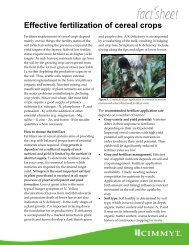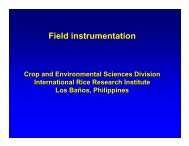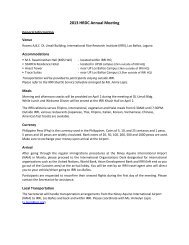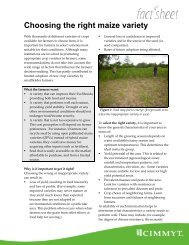Water management in irrigated rice - Rice Knowledge Bank ...
Water management in irrigated rice - Rice Knowledge Bank ...
Water management in irrigated rice - Rice Knowledge Bank ...
- No tags were found...
Create successful ePaper yourself
Turn your PDF publications into a flip-book with our unique Google optimized e-Paper software.
fertilized vegetables were <strong>in</strong>cluded <strong>in</strong> the cropp<strong>in</strong>gsystem (Bouman et al 2002). In traditional<strong>rice</strong> systems, relatively few herbicides are used aspuddl<strong>in</strong>g, transplant<strong>in</strong>g, and the pond<strong>in</strong>g of waterare effective weed control measures. Mean biocideuse <strong>in</strong> <strong>irrigated</strong> <strong>rice</strong> varies from some 0.4 kg active<strong>in</strong>gredients (a.i.) ha −1 <strong>in</strong> Tamil Nadu, India, to 3.8kg a.i. ha −1 <strong>in</strong> Zhejiang Prov<strong>in</strong>ce, Ch<strong>in</strong>a (Bouman atal 2002). In the warm and humid conditions of thetropics, volatilization is a major process of biocideloss, especially when biocides are applied on thesurface of water or on wet soil (Sethunathan andSiddaramappa 1978). The relatively high temperaturesfurther favor rapid transformation of the rema<strong>in</strong><strong>in</strong>gbiocides by (photo)chemical and microbialdegradation, but little is known about the toxicity ofthe residues. In case studies <strong>in</strong> the Philipp<strong>in</strong>es, meanbiocide concentrations <strong>in</strong> groundwater underneath<strong>irrigated</strong> <strong>rice</strong>-based cropp<strong>in</strong>g systems were one totwo orders of magnitude below the s<strong>in</strong>gle (0.1 µgL −1 ) and multiple (0.5 µg L −1 ) biocide limits for safedr<strong>in</strong>k<strong>in</strong>g water, although temporary peak concentrationsof 1.14−4.17 µg L −1 were measured (Boumanet al 2002). As for nitrogen, however, biocidesand their residues may be directly transferred toopen water bodies through dra<strong>in</strong>age water flow<strong>in</strong>goverland out of <strong>rice</strong> fields. The potential for waterpollution by biocides is greatly affected by fieldwater <strong>management</strong>. Different water regimes result<strong>in</strong> different pest and weed populations and densities,which farmers may combat with different amountsand types of biocides. Residual biocides <strong>in</strong>teractdifferently with soil under different water regimes(Sethunathan and Siddaramappa 1978).4.3 Effects of water scarcity<strong>Water</strong> scarcity affects not only the ability of <strong>rice</strong>fields to produce food but also the environmentand the other ecosystem services of <strong>rice</strong> fields.Increas<strong>in</strong>g water scarcity is expected to shift <strong>rice</strong>production to more water-abundant delta areas,and to lead to less flooded conditions <strong>in</strong> <strong>rice</strong> fieldsand to the <strong>in</strong>troduction of upland crops that do notrequire flood<strong>in</strong>g. These changes will have environmentalconsequences and will affect the traditionalecosystem services of the <strong>rice</strong> landscape.<strong>Rice</strong> that is not permanently flooded tendsto have more weed growth and a broader weedspectrum than <strong>rice</strong> that is permanently flooded(Mortimer and Hill 1999). It is expected that watershortages will lead to more frequent use of herbicides,which may <strong>in</strong>crease the environmental loadof herbicide residues. With less water, the numbersand types of pests and predators (e.g., spiders) maychange as well as predator-pest relationships. Thepossible shift <strong>in</strong> the use of pesticides by farmers<strong>in</strong> response to these changes, and what this meansfor the environment, is as yet unknown. Moreleach<strong>in</strong>g of nitrate is expected with <strong>in</strong>creased soilaeration (either with grow<strong>in</strong>g <strong>rice</strong> under nonfloodedconditions, or with the shift to upland crops) thanunder flooded conditions. Less methane emissionsare expected under aerobic conditions than underflooded conditions, but higher nitrous oxide emissionsare expected (Bronson et al 1997a,b). However,the relative emissions of these greenhouse gases varywith environment and <strong>management</strong> practices (Dittertet al 2002). Flooded <strong>rice</strong> is effective <strong>in</strong> leach<strong>in</strong>gaccumulated salts from the soil profile, and thechange to more aerobic conditions may result <strong>in</strong><strong>in</strong>creased sal<strong>in</strong>ization.There is little <strong>in</strong>formation on how waterscarcity will affect the ecosystem services of <strong>rice</strong>lands listed <strong>in</strong> Chapter 4.1. There is a grow<strong>in</strong>g recognitionthroughout the <strong>rice</strong>-grow<strong>in</strong>g world that abetter understand<strong>in</strong>g of the ecosystem services ofthe <strong>rice</strong> environment is needed. Although somemethodologies exist to measure and estimate differentservices of agricultural systems, quantify<strong>in</strong>gand valu<strong>in</strong>g the positive and negative externalitiesstill presents a major challenge. In many countries,relevant data at the appropriate geographic levelare not available.37





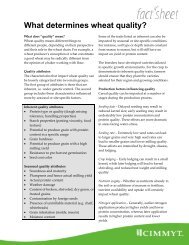

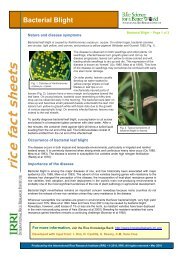

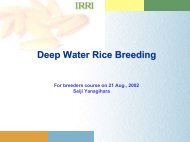
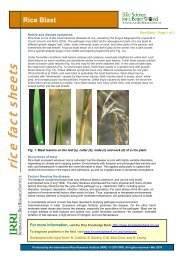
![International Standards' Organization â Rice Specification [ISO 7301]](https://img.yumpu.com/36696862/1/190x245/international-standards-organization-a-rice-specification-iso-7301.jpg?quality=85)

